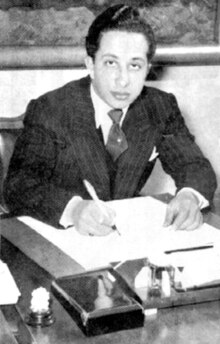Coup in Iraq 1958
On July 14, 1958 , a coup took place in the Hashemite Kingdom of Iraq . In the course of this, nationalist officers of the Iraqi armed forces overthrew the pro-British monarchy. As a result of the coup, King Faisal II , Crown Prince Abd ul-Ilah and Prime Minister Nuri as-Said were murdered by the putschists. Leading heads of the coup were officers around Abd al-Karim Qasim and Abd al-Salam Arif , with Qasim dismissing his deputy Arif the following year. The change of power led to the establishment of the Republic of Iraq , Qasim became Prime Minister. The overthrow carried out in this way was considered a revolution in Iraqi historiography (" July Revolution "); July 14th was a national holiday in Iraq until 2003.
With membership in the Arab Federation and the CENTO, the newly established republic ended the pro-Western foreign policy from the time of the monarchy.
background
The British- backed Hashimite monarchy had a legitimacy problem in Iraq throughout its existence. The leadership of the monarchy around the ruling family and the permanent Prime Minister Nuri As-Said claimed to want to establish a liberal democracy, but repeatedly resorted to authoritarian methods of rule. During the Second World War , the monarchy could only be maintained through the deployment of Allied troops against a pro-German military coup . In the 1950s, the support of the monarchy continued to erode. Its supporters were almost exclusively limited to the ruling classes of Sunni tribal associations privileged by the ruling house. From the 1950s onwards, Hashemite rule met with a majority rejection of the mass of the population as well as the elites in the bureaucracy and the military and the urban middle class. The example of Nasserism in Egypt fueled the desire for a violent change of power in Iraq and especially in the officer corps.
course
On July 14, 1958, military units with tanks occupied the capital Baghdad in the early hours of the morning. The putschists' armed forces consisted of two brigades . The putschists had used the government's marching orders to Jordan to support the Hashemite dynasty there and diverted the units to Baghdad. The coup had been planned within the military for two years. They did not encounter any significant organized resistance. In the days of the coup there were mass demonstrations by the population, who welcomed the coup. The mutilated bodies of prominent leaders of the monarchy such as Nuri-as-Said and Abd-ul-Ilah were publicly displayed by the mob in Baghdad.
consequences
Arif and Qasim had promised the officers who supported them a socialist political system in which central power would come from a military-staffed Revolutionary Command Council . However, after taking power, Arif and Qasim failed to hand over power to institutions, relying instead on personal connections. The formal center of power lay with a three-member council of sovereignty, to which the generals Muhammad Mahdi Kubba , the former Shiite head of the Independence Party , Khalid an-Naqschbandi, a Kurdish ex-officer, and Muhammad Najib ar-Rubai'i, a Sunni officer. In truth, however, power remained with Arif and Qasim, who controlled the country's security forces and secret services and dominated the political scene from the background. Arif himself became Minister of the Interior. Qasim served as Defense Minister and Commander in Chief of the Armed Forces.
In their cabinet they tried to involve ministers from all political directions and ethnic groups. Arif and Qasim themselves soon got into public conflict as to whether and how quickly they should join the United Arab Republic under the leadership of Gamal Abdel Nasser . Arif made much more far-reaching Nassist demands than Qasim and came increasingly into conflict with him. In nationalist circles, the two generals were quickly viewed as usurpers. In February 1959, large sections of the cabinet resigned on the charge that the government was only pursuing Nasserism as a pretext for its own rule. In March 1959 there was an uprising of officers against the government in Mosul , on the first anniversary of the revolution, in July 1959, pro - government Kurds massacred pro- government Turkmen and nationalist Arabs in Kirkuk . In October of the same year, the first attempt to assassinate Qasim was made by members of the underground Ba'ath Party . Qasim led the republic more and more as a dictatorship tailored to his person and lost more and more the support of the officer corps. This supported the takeover of power by the Ba'ath Party in 1963, which ended the Qasim regime.
Individual evidence
- ↑ Daweesha, 2012: 160-170
- ↑ Daweesha, 2009, pp. 170-172
- ↑ Marr, 2012, pp. 84–90
- ↑ Daweesba, 2009, pp. 172-183
- ↑ Marr, 2012, pp. 84–90
- ↑ Daweesba, 2009, pp. 172-183
literature
- Phebe Marr: The Modern History of Iraq. 3rd edition, Boulder, 2012
- Adeed Daweesha: Iraq: A Political History from Independence to Occupation. Princeton, 2009

